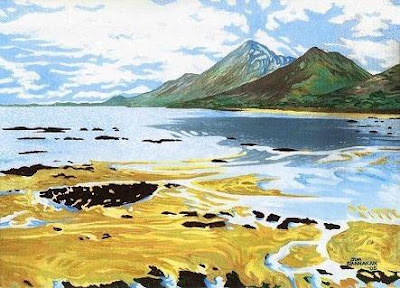
Said Hamlet to Opthelia
I'll draw a sketch of thee
What type of pencil shall I use?
2B or not 2b?
I'll draw a sketch of thee
What type of pencil shall I use?
2B or not 2b?
by Spike Milligan
Choosing a palette of colours is as personal as choosing a bottle of aftershave or perfume. A lot of it is down to personal taste. Whatever pleases the eye. Some people like a lot of dark colours and others never use black. But the most common mistake a lot of people starting out make is to have too much choice in their paintbox. Too much confusion and choice leading to incorrect colour choice and paintings that look unnatural or lacking in coherence. Improving use of colour is probably the best thing a beginner can concentrate on and well worth the effort. The best advice in choosing a palette is to travel light. With sufficient familiarity with the chosen colours most paintings can be well executed with about 15 tubes of paint. What? I hear you say. What about all the really nice shades of green or natural colours that make up the bulk of many landscape paintings.
Well the good news is all can be mixed easily and with a little practice. And once learned it means your next painting trip outdoors will be a lot lighter on the arms.
A good start is to choose a palette of about 15 colours maximum:
Found around the colour wheel roughly equally spaced:
Lemon Yellow
Cadmium Yellow (Medium)
Cadmium Orange
Cadmium Red
Permanent Rose (Like Alizarin but more lightfast)
Permanent Magenta (Midway between Permanent Rose and Permanent Mauve)
Permanent Mauve (Looks deep purple - very close to Ultramarine Violet)
Ultramarine Blue
Thalocyanine Blue (or Cobalt Blue)
Cerulean Blue (or use Manganese Blue)
Viridian
Cadmium Green Pale (or use Permanent Green Light)
Optional additional colours, Inside the colour wheel (Colours that can be mixed from the above which are commonly used):
Yellow Ochre (Mix from Cadmium Orange and Ultramarine Blue)
Raw Umber (Mix from Cadmium Orange and Permanent Mauve / Ultramarine Violet)
Burnt Umber (Mix from Cadmium Red and Cadmium Green Pale)
Venetian Red (Mix from Cadmium Orange, Slightest touch of Cadmium Red and Magenta)
Raw Sienna (Mix from Cadmium Orange and Ultramarine Violet)
Burnt Sienna (Mix from Cadmium Orange and Magenta)
All of these can be mixed from the original list but it might be useful to include some of them. I have not given the proportions of each colour to use in the mixes but try the various colour mixes and see how close you can get to the colours you need.
Titanium White (I prefer to use this as flake white contains lead)
Black is omitted as it can be mixed from the above. Raw Umber with Ultramarine blue gives an acceptable black. This gives a more natural black in my opinion.
The following link shows watercolours average position on a colour wheel and helps in defining their complements.
For Oil Painting the colour distribution is similar.
This is a start to tips on colour use. I will expand on this post when I can. Hope it helps a bit!
1 comment:
What a great blog! And realistic good advice.
I absolutely LOVE the Ophelia poem!!!
Post a Comment